#pseudonymous italian novelist
Text

Ichiro Tsuruta 鶴田一郎
めざめ (Awaking) 2003
═════════ ✾ ═════════
我決定,夠痛了。我會把我的復仇之情依附在他們夜裡幸福的嘴唇上。 我不是那個在被遺棄和缺席的打擊下支離破碎、發瘋、死去的女人。 只有幾塊碎片脫落了,其餘的我都很好。 我是完整的,我會保持完整。 對於傷害我的人,我會以實物回報。 我是黑桃皇后,我是蜇人的黃蜂,我是黑蛇。 我是刀槍不入的動物,經過火不被燒傷。
I decided, enough pain. I was not the woman who breaks into pieces under the blows of abandonment and absence, who goes mad, who dies. Only a few fragments had splintered off, for the rest I was well. I was whole, whole I would remain. To those who hurt me, I react giving back in kind. I am the queen of spades, I am the wasp that stings, I am the dark serpent. I am the invulnerable animal who passes through fire and is not burned.
─ Elena Ferrante, The Days of Abandonment《被遺棄的日子》
#ichiro tsuruta#鶴田一郎#elena ferrante#the days of abandonment#pseudonymous italian novelist#give me a high five#i am not a kind woman and I have a clear distinction between love and hate. - chu lan~*#我不是一個良善的女人並且非常地愛恨分明-朱蘭~*
15 notes
·
View notes
Text
Samuel Lover aka Ben Trovato
Samuel Lover, born on 24 February 1797 in Dublin, was an Irish novelist, poet, songwriter, and a portrait painter, also known by the pseudonym “Ben Trovato”, meaning “well invented“.This derives from an aphorism by Giordano Bruno (Italian monk, philosopher, cosmologist who was burned at the stake in Rome, in 1600 for his opinions on astronomy […]Samuel Lover aka Ben Trovato

View On WordPress
0 notes
Text
Samuel Lover aka Ben Trovato
Samuel Lover, born on 24 February 1797 in Dublin, was an Irish novelist, poet, songwriter, and a portrait painter, also known by the pseudonym “Ben Trovato”, meaning “well invented“.This derives from an aphorism by Giordano Bruno (Italian monk, philosopher, cosmologist who was burned at the stake in Rome, in 1600 for his opinions on astronomy and the nature of the universe considered…

View On WordPress
0 notes
Link
The pseudonymous novelist Elena Ferrante’s appeal to television producers remains as clear as the Tyrrhenian Sea. Sun-kissed Italian locations; prominent female leads, afforded greater agency...
0 notes
Text
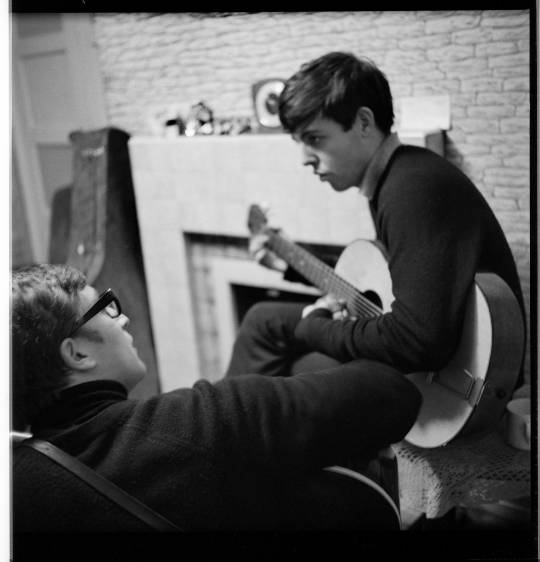
John Lennon and Sir Paul McCartney at 20 Forthlin Road (Mike McCartney/PA)
* * * *
Simon Kuper: If you put together Anna Funder’s recent book on George Orwell with Jennifer Burns’ biography of Milton Friedman, an oddly similar story emerges. Both men, especially Friedman, co-created their most famous works with their wives. In Friedman’s case, with several other women besides. Orwell’s marriage to Eileen O’Shaughnessy seems to have prompted his best writing. She had written a dystopian poem about 1984 and helped convince him to turn his anti-Stalinism into a fable, Animal Farm. A little later, Friedman had the advantage over sexist male peers in realising that there were brilliant female economists who possessed few career options beyond working for him. To quote his wife Rose: “You can’t tell who wrote what, the style is the same throughout the books. I always tell people we work as one; we are one.” Funder and Burns have given forgotten women their place in history. But their findings also point to a truth that’s becoming evident about writing: often it’s collective rather than singular. The myth of the Great Writer creating in solitude is only sometimes true.
People have long understood that most acts of creation are collaborative: pop music, sport, films, inventing the atomic bomb. Only for books, especially fiction, does the presumption of the lone genius hang on. That might have surprised Shakespeare, who co-wrote some of his plays and adapted many from other writers’ work. But at some point, literature grew snooty about collaboration. Writers who did do it, like the two cousins who co-wrote detective stories under the name Ellery Queen, often pretended there was a single author. The author Malcolm Gladwell told Vanity Fair: “Writers . . . have this false ethic of originality. Whereas musicians are like, ‘Yeah, totally — we took this little bit from that song. And it’s inspired by this.’ I love how open they are about the fact that creativity is a collective enterprise. I want writers to be able to talk that way.”
Look at what happened when two musicians, John Lennon and Paul McCartney, co-wrote. They took collaboration for granted. Their biographer Hunter Davies, who had the unfathomable privilege of sitting in Paul’s house in Cavendish Avenue, St John’s Wood, watching them write “With a Little Help from my Friends”, recounts their method. They would sit there for hours, John playing the guitar and Paul “banging on the piano”, and when one of them thought up a line, they would edit it together. “Do you believe in love at first sight?” tried John, but there weren’t enough syllables for the melody. Paul added “a” in front of love, then John changed the opening to “Would you believe . . . ” While they were writing, visitors often dropped by — one friend sat reading a horoscope magazine — and John and Paul asked them for suggestions. The two would collaborate with anyone. Davies says that their assistant roadie Mal Evans, who wasn’t even a big Beatles fan, supposedly came up with the name “Sergeant Pepper”. Lennon and McCartney, equal parts inspiration and irritation, were better together, perhaps like Orwell and O’Shaughnessy.
This kind of literary collaboration made a comeback in our century. During the “golden age of streaming”, now ending, some great novelists co-wrote television series in writers’ rooms. Dramatists in Shakespeare’s time had worked in much the same way. In my brief glimpses of writers’ rooms, I saw the potential. One day, working on a fictional series that went nowhere, our team included an Italian woman who had been flown in for her expertise in writing female characters. Every writer has weaknesses and blind spots. A good writers’ room has fewer. No wonder that one of the most admired novelists of our time, Elena Ferrante, may in fact be a writers’ room. Elena Ferrante is a pseudonym. There is a whole genre of literary sleuthing devoted to uncovering who she is. In 2018, Rachel Donadio wrote an essay in The Atlantic magazine that possibly solved the mystery. Donadio suggested that Ferrante is at least two people: Anita Raja and her husband Domenico Starnone. Other writers and editors may have chipped in, too. After all, both Raja, as a literary translator, and Starnone, a successful screenwriter, had backgrounds in collaborative writing. Donadio also unearthed Starnone’s novel Autobiografia Erotica di Aristide Gambía, never published in English, which riffs on the mystery of Ferrante’s identity and laments a male author’s inability to create female characters. Perhaps Milton Friedman was also a writers’ room and (to a much lesser degree) Orwell. They should have just said so.
[Financial Times]
#collaboration#co-writing#parnership#Elena Ferrante#Simon Kuper#words and writing#reading and writing#articles#George Orwell#women#Milton Freedman#Paul McCartney#John Lennon#with a little help from my friends
3 notes
·
View notes
Note
Hi Jennifer. I'm a mid-list author with six published books. Next year I have a book coming out that was inspired by a challenging part of my childhood. I'll be using a pseudonym at the request of a family member. The time has come for me to write my author bio and...I've got nothing. No bio I've used in the past will suffice. I'm guessing there's no point in saying So and So writes XYZ because there won't be other books out there under this name. Any advice to share?
I was thinking about how other authors who write under a pseudonym do it. There are a three ways I can think of.
First, TONS of authors use pseudonyms that are just Their Writer Identity. In other words, that is the name that goes on ALL their books, and they are not hiding behind it, it's just their author name, and their bio is their bio. But that doesn't quite feel like this.
There are some authors who write two different categories - like "E Lockhart" writes YA books, "Emily Jenkins" writes picture books. They are the same person, and Emily is not HIDING who she is, but the different pen-names make it easy to differentiate the very different kinds of books, which avoids market confusion. (You don't necessarily want your five year old who loves TOYS GO OUT to pick up WE WERE LIARS next, you know?) -- but that doesn't really feel the same as this either.
There are also a couple of instances I can think of, of authors who are ACTUALLY HIDING who they are for this book. In other words, their identity is ANONYMOUS. For example, the woman who wrote the autobiographical book HUSH used a pseud, because she was revealing secrets about a closed community and was worried about backlash for that. (Though she did, later, ultimately identify herself). This is how her bio read at the time:
"Eishes Chayil (a pseudonym meaning "woman of valor"; pronounced AY-shis CHEYE-el) was raised in a world of Chassidic schools, synagogues, and summer camps. She lives in New Jersey with her family."
Elena Ferrante is another strictly anonymous writer. Her bio on Amazon reads:
"Elena Ferrante is an Italian novelist whose true identity is not publicly known. Despite being very famous in North America, she has kept her identity secret since the publication of her first novel in 1992."
So, from these two examples, it seems that laying claim to being anonymous and basically saying the bare minimum might just be good enough.
Daffodil Teardrop is a pseudonym; the events in this book closely mirror situations from her own childhood, and the author is choosing to remain anonymous out of respect for her family.
But ... have you asked your agent and/or editor what THEY think? How are they imagining you will promote this book? Will you be strictly under wraps? Or making up a whole new identity for Daffodil, with her own website and all? or will it be more like an "E Lockhart" situation where you DO kinda claim the pseud?
10 notes
·
View notes
Photo

Presenting Zezolla Basile, cipher and story teller of the Donquixote pirates, lover to Rosinante, and user of the Yume Yume no Mi.
Devil Fruit Powers:
Yume Yume no Mi Aka, Dream Dream fruit
It allows the user to put people to sleep, link with their subconscious, and create "rooms" which are various states of lucid dreaming. When linked then the user can also create imprints of their targets so that they can be linked at any time and even with other people. And as long as the imprint was made when a person was alive it can even preserve a piece of someone that has died.
The drawback though is that the user also has to fall asleep, leaving them vulnerable on the outside. And, if the targets also realize the implications/understand the full potential of lucid dreaming then the user's control can be stolen from them.
A couple general established effects of the Dream Dream fruit are as follow:
You can be hurt or wounded, or even killed in the dream, but when you wake up you will only feel an ache.
You can eat and drink as much as you want and feel full, but when you wake your stomach will still be empty despite the contentment.
Backstory:
Zezolla was the oldest child in a family of four and had a rocky relationship with their parents due to having to shoulder so much responsibility in order to keep them all from living on the streets; selling “dreams” with the devil fruit powers they had acquired when they were in their early teens was their main source of income. Although things weren’t nearly half as bad with their mother as they were with their father, it was still pretty tense for every day home life. They had a younger brother, Romeo, who they loved dearly though. They tried not to be too overbearing with him, but growing up having to play the “parent” made it difficult to say the least and the two would get on each other’s nerves pretty frequently.
One day, even though they were supposed to be watching him, Zezolla and Romeo got into an argument and they let him leave so they could both catch a break. Most of the day went by and they didn’t think too heavily on it― when he went outside he could be gone for hours and be fine ―but the later into the evening it got then the more concerned they became. So they went out looking for him.
What they found was a nightmare.
Romeo had gone and provoked one of the more violent gangs in town and in doing so had outnumbered himself drastically. When Zezolla finally found him they had thoroughly beat him and were in the process of drowning him in the local river. The next thing Zezolla was aware of were several groaning bodies on the ground and a few that made no sound. No movement. Not even a breath escaped them.
But they were too late. Romeo wouldn’t wake up no matter how many times they tried to resuscitate him. He wouldn’t move. He wouldn’t breathe. And in their mind it was all their fault.
Not long after they left home without a word, taking their guilt with them, and tried to find some sort of meaning to their life for which they could redeem themself of their crime. They traveled all over the North Blue, selling their “dreams”, writing, telling stories, learning secrets that would sell for a pretty penny.
And that’s how Doflamingo happened upon them. He became intrigued by the things they could do and what they had to offer, and like the curator of all things rare that he was, he knew what a precious jewel could look like when properly cut and shined. So he offered them a place. A family. With nowhere else to go and, in their mind, nothing else to lose, they accepted.
Though they were cordial at best with the older members and standoffish at the worst, it was with the children that Zezolla was most open with. They grew up being the “parent”. It was what they were best at even with how much they butted heads with their brother. And guilt was most persuasive in that they swore to do better. To be more responsible. To never fail another child again. If anyone hurt those kids it was Zezolla they had to deal with.
Naturally, this led to quite the clash between them and the captain’s brother and holder of the Heart title, Rosinante. If it weren’t for a certain mission together then they might never have come to understand one another at all...
Fun Facts:
Zezolla is named after the Cinderella in the Italian adaption ‘Cenerentola’ by Giambattista Basile, and their last name is a courtesy of the author as well.
During their time wandering and in the very beginning of their days as a Donquixote pirate they went by the pseudonym ‘Scribe’.
They hoped to one day become a novelist.
#scribe's work#{tell me a story cinderella: Zezolla Basile}#death mention#on the left is a zolla in the beginning of it all#and on the right is a zolla around the time of the dressrosa arc/probably a few years prior
17 notes
·
View notes
Photo
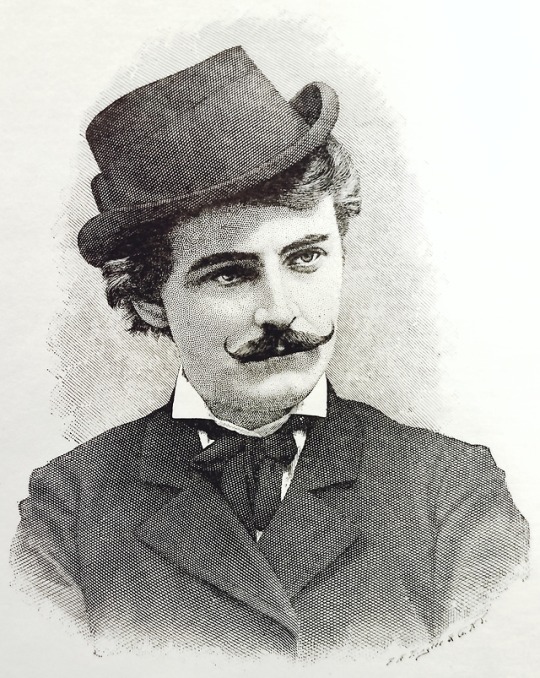


Francis Saltus Saltus (November 23, 1849 – June 24, 1889)
American poet. he was the elder half-brother of once popular but now relatively obscure novelist Edgar Saltus. Saltus was the leader of a group of bohemians in New York, including his brother Edgar and the young James Huneker, which met at Billy Moulds' bar in Manhattan's University Place; they were fond of absinthe and had "a taste for anything exotic". Van Wyck Brooks remarked that the unhappy Saltus "looked like a Greek god gone to ruin, partly as a result of the absinthe that he drank to excess". His verse reflects a refined, erotic and decadent temperament similar to that of his brother (he was the elder half-brother of once popular but now relatively obscure novelist Edgar Saltus), inspired primarily by Edgar Allan Poe, Théophile Gautier (of whom he was a student) and Charles Baudelaire. He was praised by influential editor William Marion Reedy as an 'American Baudelaire' whose verse had "the perfume of exquisite sadness."
Able to converse in ten languages, Saltus also wrote poems in Italian, German and French. A talented musician, he wrote four comic operas and much musical criticism. Much of his humorous, commercial work was written under the pseudonym Cupid Jones. Saltus wrote and edited a comic paper entitled the Thistle in the 1870s, the entire contents of which were written by him and signed with various pseudonyms. Saltus left behind a good deal of unpublished material, including "five thousand lyrics for posthumous publication" and several musical biographies, including a life of Gaetano Donizetti which was never published. (Wikipedia)
From our stacks: Frontispiece “F. S. Saltus. F. A. Ringter & G.A.T.” and poem ‘The Confession of a Library Clerk.’ from Fact and Fancy. Humorous Poems by Cupid Jones. New York: G. P. Putnam’s Sons. The Knickerbocker Press, 1895.
#francis saltus saltus#francis saltus#saltus#cupid jones#writer#poet#linguist#composer#musician#poets#poetry#confessions of a library clerk#library#libraries#poem#poems#american poetry#american poet#american poets#american literature#literature#literary#writers#illustration#engraving#book illustration#book#books#old book#old books
99 notes
·
View notes
Photo
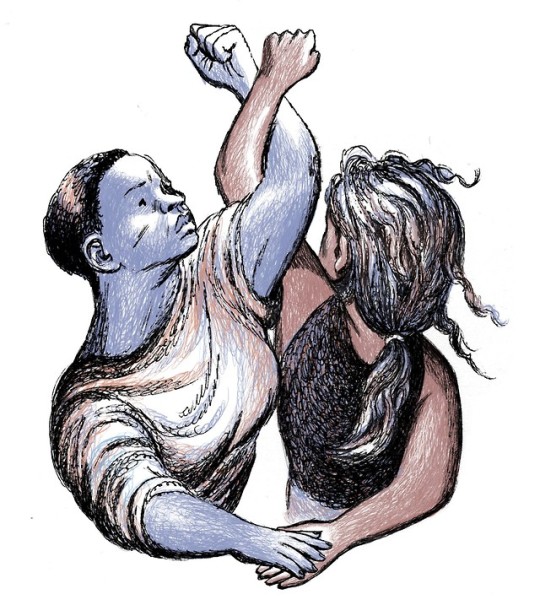
Elena Ferrante: A Power of Our Own via The New York Times
Excellent opinion piece by Elena Ferrante (a pseudonym for an Italian novelist, author of the four Neapolitan novels beginning with ‘My Brilliant Friend’ that have been turned into an HBO series).
It covers the power of storytelling and the way the world needs to adapt to the way women wield power.
3 notes
·
View notes
Photo

Second Saint of the Day – 7 March – Blessed Leonid Feodorov (1879-1935) Priest, Martyr, Monk, Exarch of the Russian Greek Catholic Church of the See of Peter, Philosopher. Born as Leonid Ivanovich Feodorov on 4 November 1879 at Saint Petersburg, Russia and died on 7 March 1935 of “natural causes”. His body is buried at Kirov, Russia.
Feodorov was born in Saint Petersburg, Russia, on 4 November 1879, into a Russian Orthodox family. His father, Ivan, was a moderately successful restaurant owner and the son of a serf. His mother, Lyuba Feodorov, a woman of Greek descent, raised him as a single mother after his father’s early death. Although she attempted to raise her son as a devout member of the Russian Orthodox Church, she simultaneously encouraged him to read the popular novelists of the day.
He later recalled, “So I began to devour the best known French novelists of the day, Zola, Hugo, Maupassant and Dumas. I became acquainted with the Italian Renaissance and its corrupt literature, Boccaccio and Ariosto. My head came to be like a sewer into which the foulest muck was emptied.”
After his graduation from the Second Imperial Gymnasium in 1901, he enrolled in the Orthodox Ecclesiastical Academy in order to study for the priesthood in the Russian Orthodox Church. After much soul-searching, he left the academy in the summer of 1902 and travelled to Rome by way of Austrian-ruled Lviv, where Metropolitan Andrey Sheptytsky of the Ukrainian Greek Catholic Church blessed his mission.
On 31 July 1902, Feodorov was formally received into the Catholic Church at the Church of the Gesù in Rome. In the aftermath, he began studying at the Jesuit seminary at Anagni under the pseudonym of “Leonidas Pierre,” which was meant to keep the Tsar’s secret police, or Okhrana, off his trail.
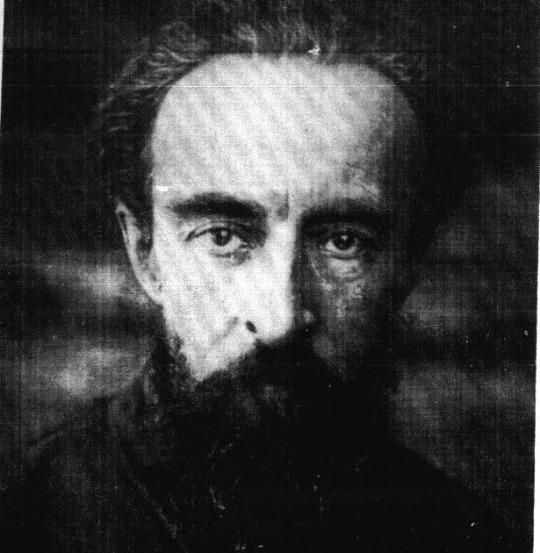
Although Leonid had originally promised to adopt the Latin Rite, while studying in the Jesuit seminary at Anagni, he came to believe that it was his duty to remain faithful to the liturgy and customs of the Christian East. With the full permission and encouragement of Pope Pius X, Leonid transferred to the Russian Byzantine Catholic Church. As a result of his decision, Leonid was disowned by his former Jesuit mentor and afterwards depended for his finances on Metropolitan Andrei Sheptytsky of Lviv.
On 25 March 1911, he received ordination in Bosnia as a Byzantine rite priest. He spent the following years as a monk in Bosnia and Ukraine and was tonsured with monastic name ‘Leontiy’ on 12 March 1913.
On the eve of the First World War, he returned to Saint Petersburg whereupon he was immediately exiled to Tobolsk in Siberia as a potential threat to the Tsar’s government which held Russian Orthodoxy as its state religion.
After the February Revolution, the Provisional Government ordered the release of all political prisoners. Pope Benedict XV named him Exarch of Russian Catholics of Byzantine rite. A three-day Synod of the Russian Byzantine Catholic Church opened in Saint Petersburg under the leadership of Metropolitan Andrey.

Open persecution of religion began in 1922. The clergy were forbidden to preach religion to anyone under eighteen years of age. Then, all sacred objects were ordered to be seized for “famine relief” and lay councils were installed in each parish with the intention of making the priest a mere employee. When both the Exarch Leonid and the Latin Rite Archbishop Jan Cieplak refused to permit this, all Catholic parishes were forcibly closed by the State.
In the spring of 1923, Exarch Leonid, Archbishop Cieplak, Monsignor Konstanty Budkiewicz and fourteen other Catholic priests and one layman were summoned to Moscow trial before the revolutionary tribunal for counter-revolutionary activities. The international uproar which followed the trial gave the Soviet government pause, however. Leonid was sentenced to prison but serving the first three years of his sentence in Moscow’s Butyrka prison, he was transported to enforced labour in Siberia – the Gulag in the White Sea.
There, in a former monastery, now a prison, Blessed Leonid was a pioneer of ecumenism together with the Orthodox with whom he shared the harsh captivity. In Solovki, Roman Catholic Mass was offered in a chapel which had been restored for the purpose with the permission of the guards. Exarch Leonid would offer the Divine Liturgy of the Russian Byzantine Catholic Church every other Sunday. When the camp authorities cracked down on this in 1929, the Masses continued in secret.
On 6 August 1929, Exarch Leonid was released to the town of Pinega and put to work making charcoal. After continuing, against all odds, to teach the Catechism to young boys, he was transferred to the village of Poltava, 15 km from Kotlas, where he completed his sentence in 1932. He chose to reside in Kirov, Kirov Oblast, where, worn out by the rigours of his imprisonment, he died on 7 March 1935.
On 27 June 2001, Exarch Leonid Feodorov was Beatified by Pope John Paul II. He remains deeply venerated among Russian Greek Catholics and by the Eastern Catholic Church. He is regarded as a Martyr Killed Under Communist Regimes in Eastern Europe and is included in an additional memorial commemorating all of them on 29 June.

(via Saint of the Day - 7 March - Blessed Leonid Feodorov (1879-1935) Martyr)
8 notes
·
View notes
Text
On #QAnon: The full text of our Buzzfeed Interview

Ryan Broderick of Buzzfeed just published an article on this #QAnon conspiracy bullshit titled It's Looking Extremely Likely That QAnon Is A Leftist Prank On Trump Supporters. The piece features quotes from an interview we gave via email. Here’s the full email exchange.
--
Can you tell me a bit about when and how your book Q was written?
We started writing Q in the last months of 1995, when we were part of the Luther Blissett Project, a network of activists, artists and cultural agitators who all shared the name «Luther Blissett». Luther Blissett was and still is a British public figure, a former footballer, a philanthropist. The LBP spread many mythical tales about why we chose to borrow his name, but the truth is that nobody knows.
Initially, Blissett the footballer was bemused, but then he decided to play along with us and even publicly endorsed the project. Last year, during an interview on the Italian TV, he stated that having his name adopted for the LBP was «a honour». The purpose of signing all our statements, political actions and works of art with the same moniker was to build the reputation of one open character, a sort of collective "bandit", like Ned Ludd, or Captain Swing. It was live action role playing. The LBP was huge: hundreds of people in Italy alone, dozens more in other countries. In the UK, one of the theorists and propagandists of the LBP was the novelist Stewart Home.
The LBP lasted from 1994 to 1999. The best English-language account of those five years is in Marco Deseriis' book Improper Names: Collective Pseudonyms from the Luddites to Anonymous. One of our main activities consisted of playing extremely elaborate pranks on the mainstream media. Some of them were big stunts which made us quite famous in Italy. The most complex one was played by dozens of people in the backwoods around Viterbo, a town near Rome. It lasted a year, involving Satanism, black masses, Christian anti-satanist vigilantes and so on. It was all made up: there were neither Satanists nor vigilantes, only fake pictures, strategically spread rumours and crazy communiqués, but the local and national media bought everything with no fact-checking at all, politicians jumped on the bandwagon of mass paranoia, we even managed to get footage of a (rather clumsy) satanic ritual broadcast in the national TV news, then we claimed responsibility for the whole thing and produced a huge mass of evidence. The Luther Blissett Project was also responsible for a huge grassroots counter-inquiry on cases of false child abuse allegations. We deconstructed the paedophilia scare that swiped Europe in the second half of the 1990s, and wrote a book about it. A magistrate whom we targeted in the book filed a lawsuit, as a consequence the book was impounded and disappeared from bookshops, but not from the web.
This is the context in which we wrote Q. We finished it in June 1998. It came out in March 1999 and was our final contribution to the LBP.
I've been reading up about it, and it's largely believed that it's underneath the book's narrative it works as handbook for European leftists? Is that a fair assessment? I've read that many believe the book's plot is an allegory for 70s and 80s European activists?
Although it keeps triggering many possible allegorical interpretations, we meant it as a disguised, oblique autobiography of the LBP. We often described it as Blissett's «playbook», an «operations manual» for cultural disruption.
The four authors I'm speaking to now are Roberto Bui, Giovanni Cattabriga, Federico Guglielmi and Luca Di Meo correct? The four authors of Q?
You are speaking with three of the four authors of Q, and you're speaking with a band of writers called Wu Ming, which means «Anonymous» in Chinese. In December 1999 the Luther Blissett Project committed a symbolic suicide - we called it The Seppuku - and in January 2000 we launched another project, the Wu Ming Foundation, centred around our writing and our blog, Giap. The WMF is now an even bigger network than the LBP was, and includes many collectives, projects and laboratories. Luca aka Wu Ming 3 is not a member of the band anymore, although he still collaborates with us on specific side projects. Each member of the band has a nom de plume composed of the band's name and a numeral, following the alphabetical order of our surnames, thus you're speaking to Roberto Bui aka Wu Ming 1, Giovanni Cattabriga aka Wu Ming 2 and Federico Guglielmi aka Wu Ming 4.
Can you tell me a bit about your background before the Luther Blissett project?
Before the LBP we were part of a national scene that was – and still is – called simply «il movimento», a galaxy of occupied social centres, squats, independent radio stations, small record labels, alternative bookshops, student collectives, radical trade unions, etc. In the Italian radical tradition, at least after the Sixties, there was never any clearcut separation between the counterculture and more political milieux. Most of us came from left-wing family backgrounds, had roots in the working class. Punk rock opened our minds during our teenage years, then in the late 1980s and early 1990s Cyberpunk opened them even more, and inspired new practices.
When did you start noticing similarities between Q and QAnon? I know you've tweeted a bit about this, but I'd love to get as many details as I can. I feel like the details around QAnon are so sketchy that it's important to lock in as much as I can here.
We read a lot about the US alt-right, books such as Elizabeth Sandifer's Neoreaction a Basilisk or Angela Nagle's – flawed but still useful – Kill All Normies, and yet we didn't see the QAnon thing coming. We didn't know it was growing on 4chan and some specific subReddits. About six weeks ago, on June 12th, our old pal Florian Cramer – a fellow veteran of the LBP who now teaches at the Willem de Kooning Academy in Rotterdam – sent us a short email. Here's the text:
«It seems as if somebody took Luther Blissett's playbook and turned it into an Alt-Right conspiracy lore. Maybe Wu Ming should write a new article: "How Luther Blissett brought down Roseanne Barr"!»,
After those sentences there was a link to a piece by Justin Caffier on Vice. We read it, and briefly commented on Twitter, then in the following weeks more and more people got in touch with us, many of them Europeans living in the US. They all wanted to draw our attention on the QAnon phenomenon. To anyone who had read our novel, the similarities were obvious, to the extent that all these people were puzzled seeing that no US pundit or scholar was citing the book.
Have there been key moments for you that made you feel like QAnon is an homage to Q? What has lined up the best?
Coincidences are hard to ignore: dispatches signed Q allegedly coming from some dark meanders of top state power, exactly like in our book. This Q is frequently described as a Blissett-like collective character, «an entity of about ten people that have high security clearance», and at the same time – like we did for the LBP – weird "origin myths" are put into circulation, like the one about John Kennedy Jr. faking his own death in 1999 – the year Q was first published, by the way! – and becoming Q. QAnon's psy-op reminds very much of our old «playbook», and the metaconspiracy seems to draw from the LBP's set of references, as it involves the Church, satanic rituals, paedophilia...
We can't say for sure that it's an homage, but one thing is almost certain: our book has something to do with it. It may have started as some sort of, er, "fan fiction" inspired by our novel, and then quickly became something else.
There will be a lot of skepticism I think that an American political movement like QAnon could have been influenced by an Italian novel, how do you think it may have happened?
It's an Italian novel in the sense that it was originally written in Italian by Italian authors, but in the past (nearly) 20 years it has become a global novel. It was translated into fifteen languages – including Korean, Japanese, Russian, Turkish – and published in about thirty countries. It was successful all across Europe and in the English speaking world with the exception of the US, where it got bad reviews, sold poorly and circulated almost exclusively in activist circles.
Q was published in Italian a few months before the so-called "Battle of Seattle", and published in several other languages in the 2000-2001 period. It became a sort of night-table book for that generation of activists, the one that would be savagely beaten up by an army of cops during the G8 summit in Genoa, July 2001. In 2008 we wrote a short essay, almost a memoir, on our participation to those struggles and Q's influence in those years, titled Spectres of Müntzer at Sunrise. A copy of Q's Spanish edition even ended up in the hands of subcomandante Marcos. It isn't at all unrealistic to imagine that it may have inspired the people who started QAnon.
Have you seen anything in the QAnon posts that leads you to suspect any activist group in particular is behind it?
No, we haven't.
You think QAnon is a prank? Without some kind of reveal it's obviously hard to see it as that. If you think it was revealed that QAnon was actually some kind of anarchist prank, would it even matter? Would its believers abandon it or would they just see it as a smear campaign?
Let us take for granted, for a while, that QAnon started as a prank in order to trigger right-wing weirdos and have a laugh at them. There's no doubt it has long become something very different. At a certain level it still sounds like a prank, but who's pulling it on whom? Was the QAnon narrative hijacked and reappropriated by right-wing "counter-pranksters"? Counter-pranksters who operated with the usual alt-right "post-ironic" cynicism, and made the narrative more and more absurd in order to astonish media pundits while spreading reactionary content in a captivating way?
Again: are the original pranksters still involved? Is there some detectable conflict of narratives within the QAnon universe? Why are some alt-right types taking the distance from the whole thing and showing contempt for what they describe as «a larp for boomers»?
A larp it is, for sure. To be more precise, it's a fascist Alternate Reality Game. Plausibly the most active players – ie the main influencers – don't believe in all the conspiracies and metaconspiracies, but many people are so gullible that they'll gulp down any piece of crap – or lump of menstrual blood, for that matter. Moreover, there's danger of gun violence related to the larp, the precedent of Pizzagate is eloquent enough. What if QAnon inspires a wave of hate crimes?
Therefore, to us the important question is: triggering nazis like that, what is it good for? That camp is divided between those who would believe anything and those who would be "ironic" on anything and exploit anything in order to advance their reactionary, racist agenda. Can you really troll or ridicule people like those?
It's hard to foresee what would happen if QAnon were exposed as an anarchist/leftist prank on the right. If its perpetrators claimed responsibility for it and showed some evidence (for example, unmistakeable references to our book and the LBP), would the explanation itself become yet another part of the narrative, or would it generate a new narrative encompassing and defusing the previous one? In plain words: which narrative would prevail? «QAnon sucking anything into its vortex» or «Luther Blissett's ultimate prank»?
In any case, we'd never have started anything like that ourselves. Way too dangerous.
50 notes
·
View notes
Text
Curious Pseudonyms
Count O’Blather (Flann O’Brien)
Comic writer Flann O’Brien produced a monthly magazine in the 1930s under the title Blather, which he claimed was the work of one Count O’Blather and his simple-minded son Blazes. Flann O’Brien was also a pseudonym, although a less outlandish one, of the real author, Brian O’Nolan.
Hilarius Bogbinder (Søren Kierkegaard)
The Danish philosopher used many weird pseudonyms during his career, including this one, and regularly used one nom de plume to review books he had written under another.
Corno di Bassetto (George Bernard Shaw)
Shaw used this pseudonym, which is an Italian term for a type of clarinet, when he was producing regular music criticism in the 1880s and 1890s for the London press.
Miss Tickletoby (William Makepeace Thackeray)
Before he made his name with his novels, Thackeray published comic sketches and essays under countless pseudonyms. ‘Miss Tickletoby's Lectures on English History’ appeared in Punch in 1842.
Gom Gut (Georges Simenon)
The awesomely prolific crime novelist Georges Simenon published hundreds of novels, some written in a matter of days, under pseudonyms such as Gom Gut, Luc Dorsan and Christian Brulls.
#LITERARY TRIVIA#CURIOUS PSEUDONYMS#KIERJEGAARD_Soren#OBRIEN_Flann#SHAW_GB#SIMENON_Georges#THACKERAY_William
0 notes
Text
Elena Ferrante’s Class Dramas | The Nation
Elena Ferrante’s Class Dramas | The Nation
Neapolitans rest in a piazza, 1962. (Keystone / Hulton Archive / Getty Images)
Over the course of 2018, the pseudonymous Italian novelist Elena Ferrante wrote a weekly column for The Guardian’s Weekend magazine. The pieces were later collected and published as Incidental Inventions, a title sufficiently vague to allow for the capaciousness of her themes; Ferrante wrote on everything from climate…

View On WordPress
0 notes
Photo

Amazon First Reads October 2020
Wow October all ready!! Halloween seems as though it’s just a few days away then before we know it, it’ll be Guy Fawkes/Bonfire Night. I digress as it’s all about Amazon First Reads for October and again Amazon are letting their Prime Members choose two books instead of just the one.
So now I need to decide which books I’m going to choose, I always get so excited when we get a chance to choose more than one free book. As you know I can’t resist free books.
This months choices are:
Memoir
The Boy Between by Amanda Prowse & Josiah Hartley, Pages: 286, Publication Date: 1 November 2020

Synopsis: Bestselling novelist Amanda Prowse knew how to resolve a fictional family crisis. But then her son came to her with a real one…
Josiah was nineteen with the world at his feet when things changed. Without warning, the new university student’s mental health deteriorated to the point that he planned his own death. His mother, bestselling author Amanda Prowse, found herself grappling for ways to help him, with no clear sense of where that could be found. This is the book they wish had been there for them during those dark times.
Josiah’s situation is not unusual: the statistics on student mental health are terrifying. And he was not the only one suffering; his family was also hijacked by his illness, watching him struggle and fearing the day he might succeed in taking his life.
In this book, Josiah and Amanda hope to give a voice to those who suffer, and to show them that help can be found. It is Josiah’s raw, at times bleak, sometimes humorous, but always honest account of what it is like to live with depression. It is Amanda’s heart-rending account of her pain at watching him suffer, speaking from the heart about a mother’s love for her child.
For anyone with depression and anyone who loves someone with depression, Amanda and Josiah have a clear message—you are not alone, and there is hope.
Suspense
Girls of Brackenhill by Kate Moretti, Pages: 330, Publication Date: 1 November 2020

Synopsis: Haunted by her sister’s disappearance, a troubled woman becomes consumed by past secrets in this gripping thriller from the New York Times bestselling author of The Vanishing Year.
When Hannah Maloney’s aunt dies in a car accident, she returns to her family’s castle in the Catskills and the epicenter of a childhood trauma: her sister’s unsolved disappearance. It’s been seventeen years, and though desperate to start a new life with her fiancé, Hannah is compelled to question the events of her last summer at Brackenhill.
When a human bone is found near the estate, Hannah is convinced it belongs to her long-lost sister. She launches her own investigation into that magical summer that ended in a nightmare. As strange happenings plague the castle, Hannah uncovers disturbing details about the past and startling realizations about her own repressed childhood memories.
Fueled by guilt over her sister’s vanishing, Hannah becomes obsessed with discovering what happened all those years ago, but by the time Hannah realizes some mysteries are best left buried, it’s too late to stop digging. Overwhelmed by what she has exposed, Hannah isn’t sure her new life can survive her old ghosts.
Thriller
The Cipher by Isabella Maldonado, Pages: 332, Publication Date: 1 November 2020
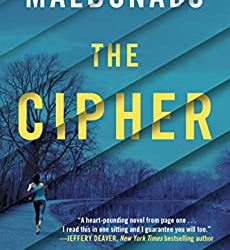
Synopsis: To a cunning serial killer, she was the one that got away. Until now…
FBI Special Agent Nina Guerrera escaped a serial killer’s trap at sixteen. Years later, when she’s jumped in a Virginia park, a video of the attack goes viral. Legions of new fans are not the only ones impressed with her fighting skills. The man who abducted her eleven years ago is watching. Determined to reclaim his lost prize, he commits a grisly murder designed to pull her into the investigation…but his games are just beginning. And he’s using the internet to invite the public to play along.
His coded riddles may have made him a depraved social media superstar—an enigmatic cyber-ghost dubbed “the Cipher”—but to Nina he’s a monster who preys on the vulnerable. Partnered with the FBI’s preeminent mind hunter, Dr. Jeffrey Wade, who is haunted by his own past, Nina tracks the predator across the country. Clue by clue, victim by victim, Nina races to stop a deadly killer while the world watches.
Book Club Fiction
This Magnificent Dappled Sea by David Biro, Pages: 255, Publication Date: 1 November 2020
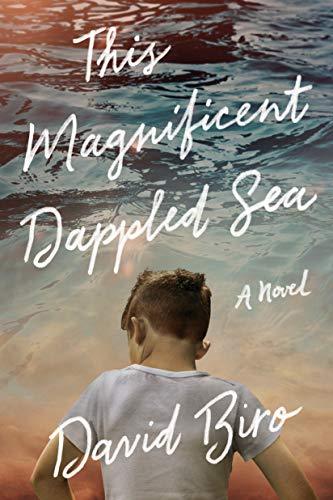
Synopsis: Two strangers—generations and oceans apart—have a chance to save each other in this moving and suspenseful novel about family secrets and the ineffable connections that lead us to one another.
In a small Northern Italian village, nine-year-old Luca Taviano catches a stubborn cold and is subsequently diagnosed with leukemia. His only hope for survival is a bone marrow transplant. After an exhaustive search, a match turns up three thousand miles away in the form of a most unlikely donor: Joseph Neiman, a rabbi in Brooklyn, New York, who is suffering from a debilitating crisis of faith. As Luca’s young nurse, Nina Vocelli, risks her career and races against time to help save the spirited redheaded boy, she uncovers terrible secrets from World War II—secrets that reveal how a Catholic child could have Jewish genes.
Can inheritance be transcended by accidents of love? That is the question at the heart of This Magnificent Dappled Sea, a novel that challenges the idea of identity and celebrates the ties that bind us together.,m.
Historical Fiction
The Last Correspondent by Soraya M Lane, Pages: 336, Publication Date: 1 November 2020

Synopsis: When journalist Ella Franks is unmasked as a woman writing under a male pseudonym, she loses her job. But having risked everything to write, she refuses to be silenced and leaps at the chance to become a correspondent in war-torn France.
Already entrenched in the thoroughly male arena of war reporting is feisty American photojournalist Danni Bradford. Together with her best friend and partner, Andy, she is determined to cover the events unfolding in Normandy. And to discover the whereabouts of Andy’s flighty sister, Vogue model Chloe, who has followed a lover into the French Resistance.
When trailblazing efforts turn to tragedy, Danni, Ella and Chloe are drawn together, and soon form a formidable team. Each woman is determined to follow her dreams “no matter what”, and to make her voice heard over the noise of war.
Europe is a perilous place, with danger at every turn. They’ll need to rely on each other if they are to get their stories back, and themselves out alive. Will the adventure and love they find be worth the journey of their lives?
Gothic Fiction
The Haunting of Brynn Wilder by Wendy Webb, Pages: 288, Publication Date: 1 November 2020

Synopsis: From the #1 Amazon Charts bestselling author of Daughters of the Lake comes an enthralling spellbinder of love, death, and a woman on the edge.
After a devastating loss, Brynn Wilder escapes to Wharton, a tourist town on Lake Superior, to reset. Checking into a quaint boardinghouse for the summer, she hopes to put her life into perspective. In her fellow lodgers, she finds a friendly company of strangers: the frail Alice, cared for by a married couple with a heartbreaking story of their own; LuAnn, the eccentric and lovable owner of the inn; and Dominic, an unsettlingly handsome man inked from head to toe in mesmerizing tattoos.
But in this inviting refuge, where a century of souls has passed, a mystery begins to swirl. Alice knows things about Brynn, about all of them, that she shouldn’t. Bad dreams and night whispers lure Brynn to a shuttered room at the end of the hall, a room still heavy with a recent death. And now she’s become irresistibly drawn to Dominic—even in the shadow of rumors that wherever he goes, suspicious death follows.
In this chilling season of love, transformation, and fear, something is calling for Brynn. To settle her past, she may have no choice but to answer.
Historical Fiction
Spellbreaker by Charlie N Holmberg, Pages: 300, Publication Date: 1 November 2020
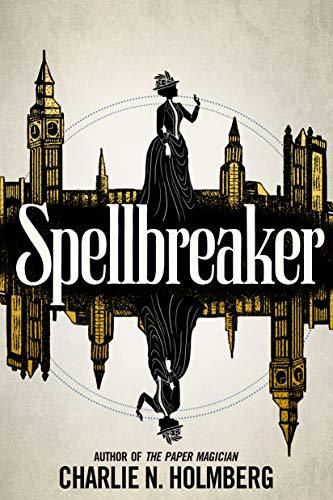
Synopsis: A world of enchanted injustice needs a disenchanting woman in an all-new fantasy series by the Wall Street Journal bestselling author of The Paper Magician.
The orphaned Elsie Camden learned as a girl that there were two kinds of wizards in the world: those who pay for the power to cast spells and those, like her, born with the ability to break them. But as an unlicensed magic user, her gift is a crime. Commissioned by an underground group known as the Cowls, Elsie uses her spell-breaking to push back against the aristocrats and help the common man. She always did love the tale of Robin Hood.
Elite magic user Bacchus Kelsey is one elusive spell away from his master-ship when he catches Elsie breaking an enchantment. To protect her secret, Elsie strikes a bargain. She’ll help Bacchus fix unruly spells around his estate if he doesn’t turn her in. Working together, Elsie’s trust in—and fondness for—the handsome stranger grows. So does her trepidation about the rise in the murders of wizards and the theft of the spell-books their bodies leave behind.
For a rogue spellbreaker like Elsie, there’s so much to learn about her powers, her family, the intriguing Bacchus, and the untold dangers shadowing every step of a journey she’s destined to complete. But will she uncover the mystery before it’s too late to save everything she loves?
Contemporary Fiction
Perfectly Impossible by Elizabeth Topp, Pages: 314, Publication Date: 1 November 2020

Synopsis: In this witty debut novel, Elizabeth Topp crafts a story that ventures behind the fanciful facade of Park Avenue and into the life of one lovable type A assistant.
Anna’s job is simple: prevent the unexpected from happening and do everything better than perfectly. An artist at heart, Anna works a day job as a private assistant for Bambi Von Bizmark, a megarich Upper East Side matriarch who’s about to be honored at the illustrious Opera Ball.
Caught between the staid world of great wealth and her unconventional life as an artist, Anna struggles with her true calling. If she’s supposed to be a painter, why is she so much more successful as a personal assistant? When her boyfriend lands a fancy new job, it throws their future as a couple into doubt and intensifies Anna’s identity crisis. All she has to do is ensure everything runs smoothly and hold herself together until the Opera Ball is over. How hard could that be?
Featuring a vibrant array of characters from the powerful to the proletarian, Perfectly Impossible offers a glimpse into a world you’ll never want to leave.
Children’s Picture Book
Some Days Written & Illustrated by Maria Wernicke, Translated by: Lawrence Schimel, Pages: 24, Publication Date: 1 November 2020

Synopsis: From an Astrid Lindgren Memorial Award nominee comes a touching story of family, security, and loss.
A young girl tells her mother about a passageway in their yard. Down this passageway, it is not cold, there is no danger, and nothing bad can ever happen—and the person she longs for is with her again. The only problem is that, on some days, the passageway is not there. But maybe, together, mother and daughter can find a way to carry that feeling with them always.
First published in Argentina, this lovely picture book will tug on the heartstrings of anyone who knows what it means to miss a loved one.
#AmazonFirstReads, #Amazonkindle, #AmazonPrimeMembers, #BookClubFiction, #Books, #ChildrensPictureBook, #ContemporaryFiction, #GothicFiction, #HistoricalFiction, #Kindle, #KindleBooks, #Memoir, #Suspense, #Thriller

0 notes
Text
The continuing influence of “The Conformist”
Normal people
The continuing influence of “The Conformist”
Fifty years on, Bernardo Bertolucci’s portrait of fascism is still chilling
Books, arts and culture
Prospero
Jul 1st 2020
by J.B. | VENICE
BORN IN 1941, Bernardo Bertolucci grew up amid the cultural renaissance of post-war Italy. The years of fascist rule were over; in cinema neorealism became eminent, while Italian chic was taking over the world of fashion. Bernardo’s father, Attilio Bertolucci, was a famous poet and film critic; Bernardo began writing aged 15 with a view to pursuing a career in poetry. It was at the University of Rome—and thanks to Attilio’s connections—that he was introduced to film-making. He worked as an assistant to Pier Paolo Pasolini, a neorealist director, and made his first film at 22. By 1970, and not yet 30, he had made five movies and collaborated with some of Italy’s most acclaimed auteurs.
It was in 1970 that Bertolucci would release his masterpiece. He counted among his friends Alberto Moravia, a novelist who had been so critical of Benito Mussolini’s regime that his books had been censored and he had been forced to write under a pseudonym. In 1951 Moravia had published “The Conformist”, a postmortem of fascism steeped in the same existential dread as Albert Camus’s “The Outsider” (1942). Bertolucci’s adaptation of “The Conformist”, which had its premiere 50 years ago on July 1st 1970, catapulted him to international fame.
The conformist of the title, Marcello Clerici (Jean-Louis Trintignant), longs to lead what he considers a “normal life”. In Rome in 1936, normality means joining the National Fascist Party, and Marcello uses his friendship with a right-wing intellectual to get a job interview at the secret police. The colonel who assesses Marcello considers him an enigma, motivated neither by ideology nor by money, yet accepts him to the force anyway. Indeed, Marcello seems willing to assume any intellectual posture. He goes to confession at the behest of Giulia (Stefania Sandrelli), his socialite fiancée, despite the fact that he is not a believer. His apparent embrace of Catholicism—much like his marriage and his fascism—is part of his pursuit of normality.
Marcello’s honeymoon provides the cover for his first mission as a thug for the Organisation for Vigilance and Repression of Anti-Fascism. The newlyweds set off for Paris, where he is to make contact with his old university tutor, Professor Quadri (Enzo Tarascio), whom the fascists want dead because of his vocal opposition to the regime. In Bertolucci’s non-linear narrative, the film begins in Paris on the morning of the assassination attempt as Marcello and an associate pursue Quadri and his wife, Anna (Dominique Sanda), through the snowy French countryside.
From there, the film jumps backwards and forwards in time, and flashbacks grasp at the mystery of what drives Marcello. Perhaps his need for normality is rooted in the dysfunction of his own upper-class family, given that his father is in an insane asylum and his mother is a morphine addict. Perhaps it is a result of a traumatic event in his childhood: the film suggests that Marcello was the victim of sexual abuse, but it is unclear what exactly took place and whether the young boy did kill his abuser in self-defence.
Throughout, the protagonist remains a slippery subject. Marcello readily admits that he doesn’t love Giulia and, once in Paris for their honeymoon, embarks on an affair with Anna, who in turn is intent on seducing Giulia herself. The only constant is Marcello’s indecision about whether he will go through with the murder. When given a gun, he strikes a series of poses, but later admits he doesn’t even know how to use it. His attitude is one of ironic detachment. His fascist salute seems like a provocative joke.
The film itself maintains an ironic detachment and there is a dissonance between the bitterness of the story and its cinematic beauty. The lush score is by Georges Delerue, who also provided the music for Jean-Luc Godard’s “Le Mépris” (1963), another adaptation of Moravia’s work. Vittorio Storaro’s cinematography is stunning: he uses a bright palette of golds and blues to evoke Paris, contrasting it with the shadowy greys of fascist Rome. The film’s aesthetic is influenced by American gangster movies, as well as by the so-called Telefoni Bianchi (“white telephone”) films of the fascist period, with impeccable period design and decadent villas. The colours, the way the camera moves and the editing all highlight that this is a production which, like Marcello, is well aware of its own posturing.
“The Conformist” would become a major influence on the “New Cinema” movement of the 1970s and early 1980s and on later artists. Francis Ford Coppola recruited Storaro to shoot “The Godfather Part 2” and “Apocalypse Now”, while the Coen Brothers used Bertolucci’s film as a visual template for their debut feature, “Blood Simple”. An alienated and unreliable antihero was a crucial part of Martin Scorsese’s “Taxi Driver”. An episode of “The Sopranos”, called “Pine Barrens”, is an extended homage to “The Conformist”.
Bertolucci’s work is chillingly relevant in 2020, too, given the recent rise of nationalist extremism. Despite its ambiguities “The Conformist” is uncompromising in its condemnation of Marcello: it suggests that his narcissistic nihilism is worse than fascism, even as it facilitates it. In the end, there is little difference between playing at being a fascist and being one.
https://ift.tt/38jRKDD
0 notes
Photo

CALLIOPE WOODS !
BASICS
full name: calliope evangelina woods.
status/occupation: fashion designer / part-time novelist.
nickname(s): callie, poppy, cantaloupe / canopy, her pseudonym amelia harrow.
age: twenty-six / six hundred and seventeen.
date of birth: december 9th, 1400
gender identity: cisfemale.
species: vampire.
sexuality: pansexual, heteromantic.
spoken language(s): english, french, italian, and moderate levels of german, portuguese, and gaelic.
PHYSICAL FEATURES
face claim: candice king.
height: 5′8.
weight: 125 lbs.
body type: slim / slender.
hair color: blonde.
eye color: blue when human, though as a vampire red when fed, black when thirsty and a deep mahogany with brown contacts.
accent: a very light english accent, as she alternates decades between london and various other places.
scars: two crescent shapes on her left shoulder when a newborn vampire attacked her about a decade after her transformation.
tattoos: none.
clothing: very high fashion and generally very on-trend. her wardrobe is a solid collection of dresses, honestly.
BACKGROUND
hometown: london, england.
current location: forks, washington.
financial status: upper middle class.
criminal conviction(s): claims of fraud, illegal gambling, and cheating by tampering with casino equipment, though no charges or convictions were made.
FAMILY
father: nicholas woods, deceased.
mother: clarissa clark, deceased.
sibling(s): cameron woods ( older brother ), christian woods ( older brother ), clio woods ( older sister ), cassandra woods ( younger sister ), christopher woods ( younger brother ), calista woods ( younger sister ).
children: thalia ( daughter, 7, deceased ), erik ( son, 3, deceased )
IN DEPTH
horoscope: sagittarius.
hogwarts house: ravenclaw.
7 deadly sins: greed.
theme song: this is gospel — panic! at the disco.
HEADCANONS
alright listen ? calliope is a good Pure just doing her best with what she’s been given
alright so she was the middle child of seven & closest with her oldest siblings but took care of her younger ones after the others were married and gone
she had two children with the man she married: a daughter thalia and a son erik, though one night there was a fire that ended up killing all three of them and almost her as well, though a vampire in the area had been passing through and saved her. badly burned, they took her to a safe place to transition, but was gone by the time she woke up
cue very bad & violent newborn year that she doesn’t not think back on with Fond Memories
she has the skill of Tactile Precognition which led to a few centuries of gambling and betting and subsequent amount of income earning. though she’s long since stopped religiously doing so, she still likes to bet on horse and car races because she loves the atmosphere
she loves fashion & designing clothes ?? i mean that’s basically her profession but she loves sketching them out and she has ?? loads of books filled with designs from the centuries
she likes to write short stories and has published several alongside a couple of novels. fiction, of course, but highly based of her experiences throughout the years
3 notes
·
View notes